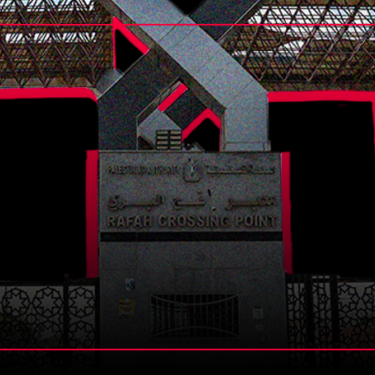“Open the gates at Rafah so that journalists can leave and enter Gaza!”

The Rafah border crossing into the south of the Gaza Strip, which has been completely closed since the start of the Israel-Hamas war, must be opened, says Reporters Without Borders (RSF). After having to evacuate the north, Gaza’s journalists are being told by Israel to gather at the border with Egypt without being able to cross, while foreign reporters are still prevented from entering
“Open the gates!” This is the call that RSF is issuing to the Israeli, as well as Egyptian authorities so that journalists can finally come and go across the border between Gaza and Egypt. With few exceptions, no journalists have been allowed to leave Gaza since 7 October, and the few who have been able to leave have not been allowed back. In the other direction, the very few journalists who have been able to enter the Gaza Strip were embedded with the Israeli army, and submitted to strict restrictions.
Palestinian journalists are literally imprisoned in the Gaza Strip, from which they cannot escape to safety. This violates UN Security Council Resolution 2222, which requires member states to protect journalists like other civilians. Conversely, foreign journalists are being denied access to the Gaza Strip. In two months of war, no reporters have been allowed to enter through Rafah, clearly undermining the media's ability to cover the conflict.
The Rafah crossing into Egypt is currently the Gaza Strip's only connection to the outside world. However, Israel is monitoring all activity at the southern border and bombed the crossing four times early in the war. This strict control has allowed Israel to prevent adequate aid from entering the Gaza Strip since Hamas’s attack More than 400 aid trucks were arriving every day before 7 October. The average is now 14, according to Reuters. This blockade has led to a shortage in the resources needed by Gaza's civilian population, including journalists.
After being forced to evacuate the entire northern part of the Gaza Strip, Palestinian journalists moved to the south, around the Nasser Hospital in Khan Yunis.
“After Israeli threats against Khan Yunis, journalists are moving to Rafah, which does not have Internet, communication services or logistical support for the media,” Saeed al-Khatib, a Gaza-based photo-journalist with Agence France-Presse told RSF. “This creates a lot of pressure and difficulty for reporters. We are trying to find alternatives with Egyptian or Israeli SIM cards.”
Since the end of the humanitarian truce between Israel and Hamas on 1 December, southern Gaza has also become the target of Israeli incursions. The only “safe” option for journalists is now Rafah, the village on the Egyptian border. But even there, the bombs are continuing to fall, RSF has been told, and it is increasingly difficult for reporters to work and transmit information to the outside world.
“While the Israeli army continues to kill journalists in Gaza – 14 in the course of their work in less than two months – and to restrict their access to vital supplies and equipment, and while Israeli disinformation campaigns undermine the entire media’s credibility, the Israeli authorities still refuse to allow international journalists access. Journalists must be able to cover this war. Gaza must not become an information black hole. We call for the urgent opening of the Rafah crossing.”
Journalists besieged in a shrinking territory
A total of 58 journalists have been killed by Israeli strikes in the Gaza Strip in the two months of war, including 14 in the course of their work, while dozens of media premises have been destroyed.
“We live in a state of siege,” the famous freelance photo-journalist Motaz Azaiza posted on his Instagram account. “We cannot go south or north, Israeli tanks surround both sides.” The day after that post, he reported that he narrowly escaped shots coming from an Israeli tank while filming near the Salah al-Din highway with several colleagues who, like him, were wearing press-labelled bulletproof vest and helmets.
